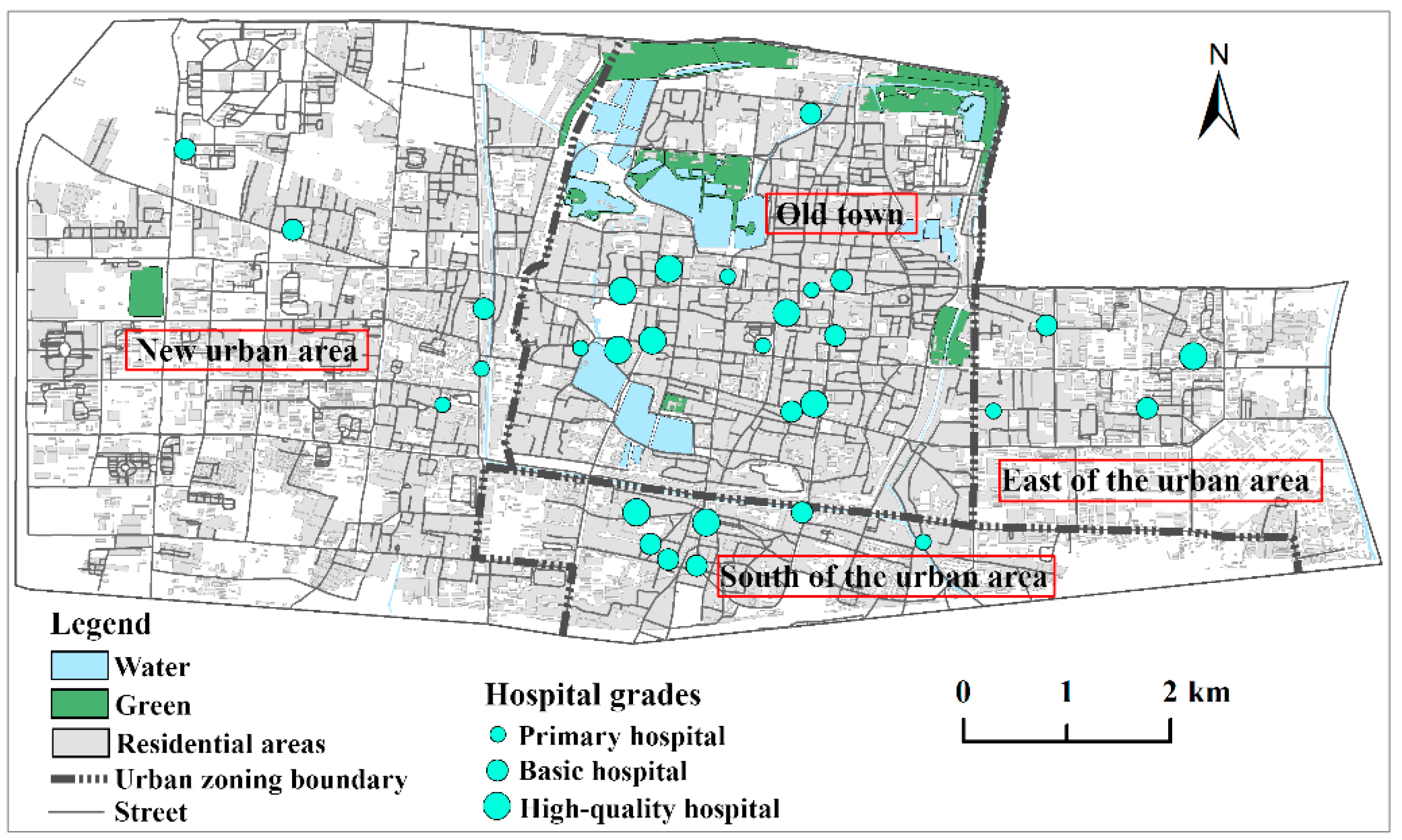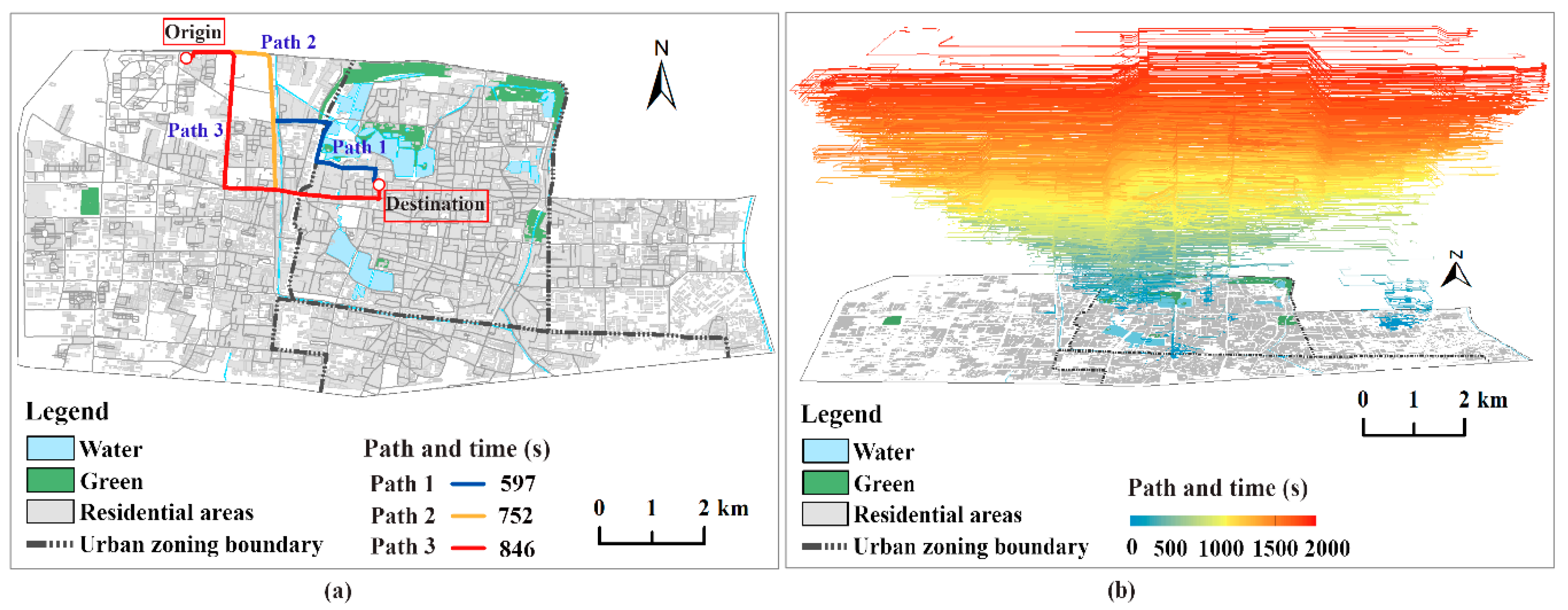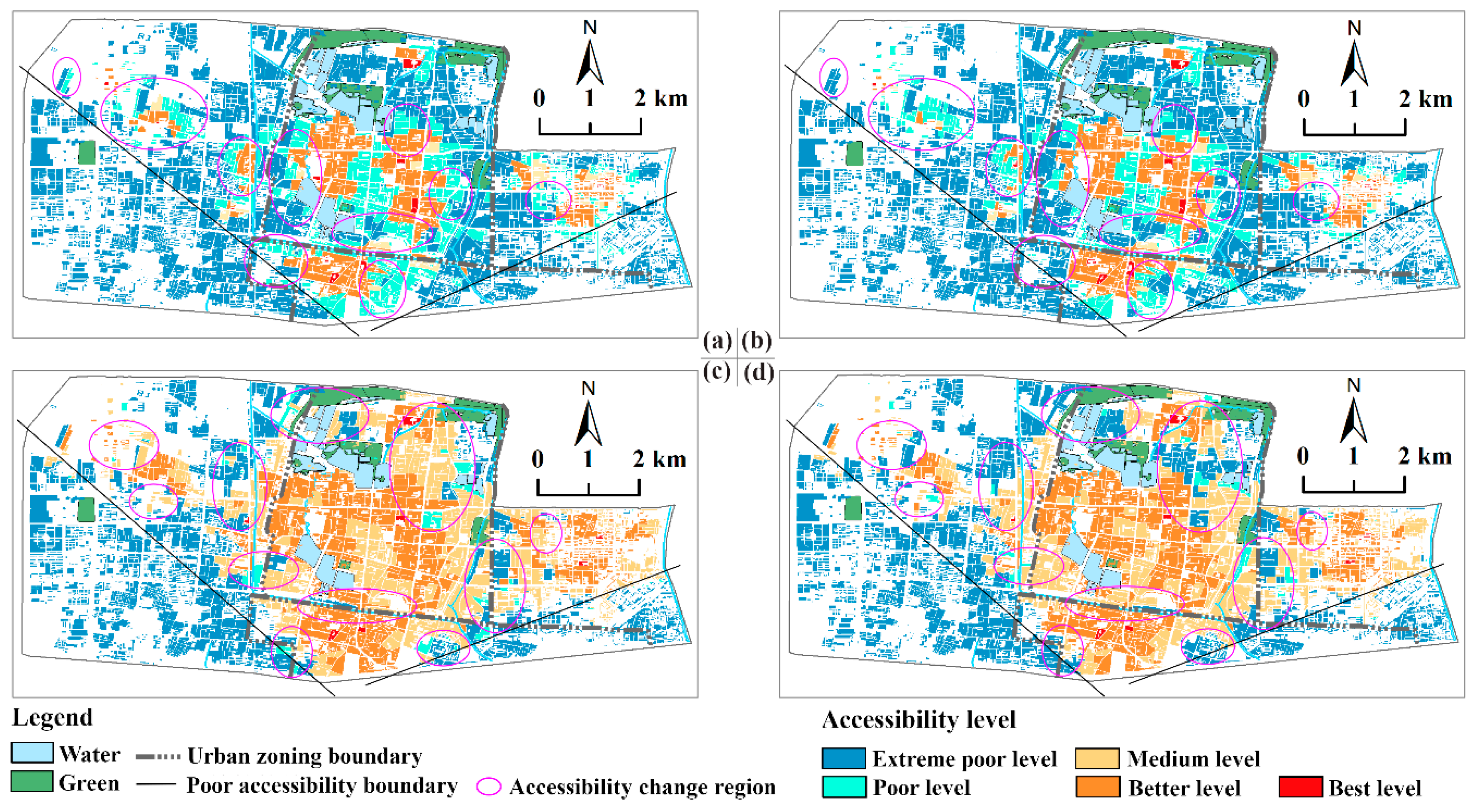Spatial Accessibility to Hospitals Based on Web Mapping API: An Empirical Study in Kaifeng, China
Abstract
1. Introduction
2. Materials and Methods
2.1. Overview of the Study Area
2.2. Data
2.3. Travel Time
2.4. Methods
3. Results
3.1. Baseline Indicators of Hospital Accessibility
3.2. Frequency Distribution of Accessibility Level
3.3. Spatial Distribution of Accessibility Level
4. Discussion and Conclusions
Author Contributions
Funding
Acknowledgments
Conflicts of Interest
References
- Zhao, X.; Wang, W.; Wan, W. Regional inequalities of residents’ health level in China: 2003–2013. Acta Geogr. Sin. 2017, 72, 685–698. [Google Scholar]
- WHO Sustainable Health Financing, Universal Coverage and Social Health Insurance. Available online: http://apps.who.int/iris/bitstream/10665/20383/1/WHA58_ 33-en (accessed on 27 November 2018).
- Zeng, W.; Xiang, L.; Li, H.; Zhang, X.; Zhang, H. Spatial Pattern of Access to Health Care Facilities and Its Formation Mechanism in Nanjing. Econ. Geogr. 2017, 37, 136–143. [Google Scholar]
- Tobias, M.; Silva, N.; Rodrigues, D. A107 perception of health and accessibility in amazonia: An approach with gis mapping to making decision on hospital location. J. Trans. Health 2015, 2, 60–61. [Google Scholar] [CrossRef]
- Tali, A.F.; Asima, N.; Aasif, N. Accessibility to Higher Order Public Health Centers a Study of District Pulwama (J&K). Int. J. Sci. Res. Sci. Technol. 2017, 3, 55–61. [Google Scholar]
- Neng, W.; Bin, Z.; Troy, S. A three-step floating catchment area method for analyzing spatial access to health services. Int. J. Geogr. Inf. Sci. 2012, 26, 1073–1089. [Google Scholar]
- Zhen, L.; Ping, W. Establishing Primary Care to Correct Misallocation of Health care Resource. Chin. Health Econ. 2011, 30, 24–27. [Google Scholar]
- Si, Z.; Shi, Y. The Impacts of Class 3A Comprehensive Hospitals on Population Distribution and Housing Price—Take Children’s Hospital of Fudan University for Example. Econ. Geogr. 2013, 33, 74–81. [Google Scholar]
- National Health and Family Planning Commission. China Statistical Yearbook of Health and Family Planning (2015); Chinese Union Medical University Press: Beijing, China, 2015.
- Yang, L.; Li, H.; Li, Y.; Wang, W.; Tan, J. Progress of medical geography and environmental health studies. Prog. Geogr. 2010, 29, 31–44. [Google Scholar]
- Smyth, F. Medical geography: Understanding health inequalities. Prog. Hum. Geogr. 2008, 32, 119–127. [Google Scholar] [CrossRef]
- Ahmad, S. A GIS Based Investigation of Spatial Accessibility to Health Care Facilities by Local Communities within an Urban Fringe Area of Melbourne. Masters Thesis, RMIT University, Melbourne, Australia, 2012. [Google Scholar]
- Braveman, P. Health disparities and health equity: Concepts and measurement. Annu. Rev. Public Health 2006, 27, 167–194. [Google Scholar] [CrossRef]
- Kirby, R.S. Geography of Health Inequalities in the Developed World: Views from Britain and North America. Prof. Geogr. 2010, 57, 615–617. [Google Scholar] [CrossRef]
- Zhou, J.; Zhong, X. Social Justice in Urban planning: Reflections on Urban Planning in a Perspective of Social Space. Urb. Plann. For. 2016, 5, 9–12. [Google Scholar]
- Wang, X.; Yang, H.; Duan, Z.; Pan, J. Spatial accessibility of primary health care in China: A case study in Sichuan Province. Soc. Sci. Med. 2018, 209, 14–24. [Google Scholar]
- Guagliardo, M.F. Spatial accessibility of primary care: Concepts, methods and challenges. Int. J. Health Geogr. 2004, 3, 3. [Google Scholar] [CrossRef] [PubMed]
- Wang, F. Measurement, Optimization, and Impact of Health Care Accessibility: A Methodological Review. Ann. Assoc. Am. Geogr. 2012, 102, 1104–1112. [Google Scholar]
- Hansen, W.G. How Accessibility Shapes Land Use. J. Am. Inst. Plan. 1959, 25, 73–76. [Google Scholar] [CrossRef]
- Dalvi, M.Q.; Martin, K.M. The measurement of accessibility: Some preliminary results. Transportation 1976, 5, 17–42. [Google Scholar] [CrossRef]
- Wisniewski, S. Spatial Accessibility of Hospital Healthcare in Lodz Voivodeship. Quaest. Geogr. 2016, 35, 157–166. [Google Scholar] [CrossRef]
- Hare, T.S.; Barcus, H. Geographical accessibility and Kentucky’s heart-related hospital services. Appl. Geogr. 2007, 27, 181–205. [Google Scholar] [CrossRef]
- Sun, Y.; Lv, B.; Zhao, Y. A Study of County Public Service Facilities Distribution Assessment Based on Behavior Investigation and GIS: A Case Study of Medical Facilities in Dengxing. Hum. Geogr. 2015, 30, 103–110. [Google Scholar]
- Cheng, G.; Zeng, X.; Duan, L.; Lu, X.; Sun, H.; Jiang, T.; Li, Y. Spatial difference analysis for accessibility to high level hospitals based on travel time in Shenzhen, China. Habitat Int. 2016, 53, 485–494. [Google Scholar]
- Hou, S.; Jiang, H. An analysis on accessibility of hospitals in Changchun based on urban public transportation. Geogr. Res. 2014, 33, 915–925. [Google Scholar]
- Talen, E. School, Community, and Spatial Equity: An Empirical Investigation of Access to Elementary Schools in West Virginia. Ann. Assoc. Am. Geogr. 2001, 91, 465–486. [Google Scholar] [CrossRef]
- Yin, C.; He, Q.; Liu, Y.; Chen, W.; Gao, Y. Inequality of public health and its role in spatial accessibility to medical facilities in China. Appl. Geogr. 2018, 92, 50–62. [Google Scholar]
- Song, Z.N.; Chen, W.; Che, Q.; Zhang, L. Measurement of Spatial Accessibility to Health Care Facilities and Defining Health Professional Shortage Areas Based on I mproved Potential Model—A Case Study of Rudong County in Jiangsu Province. Sci. Geogr. Sin. 2010, 30, 213–219. [Google Scholar]
- Song, Z.; Yan, T.; Liu, T.; Huang, T. A new gravity P-median model and empirical test in urban comprehensive hospital location decision making: Take Wuxi as an example. Prog. Geogr. 2016, 35, 420–430. [Google Scholar]
- Delamater, P.L. Spatial accessibility in suboptimally configured health care systems: A modified two-step floating catchment area (M2SFCA) metric. Health Place 2013, 24, 30–43. [Google Scholar] [CrossRef]
- Luo, J.; Chen, G.; Li, C.; Xia, B.; Sun, X.; Chen, S. Use of an E2SFCA method to measure and analyse spatial accessibility to medical services for elderly people in wuhan, china. Int. J. Environ. Res. Public Health 2018, 15, 1503. [Google Scholar] [CrossRef]
- Liu, Z.; Yang, H.; Xiong, W.; Chen, G. Spatial Accessibilities of Medical Services at County Level Based on Optimized Two-step Floating Catchment Area Method. Sci. Geogr. Sin. 2017, 37, 728–737. [Google Scholar]
- Yiannakoulias, N.; Bland, W.; Svenson, L.W. Estimating the effect of turn penalties and traffic congestion on measuring spatial accessibility to primary health care. Appl. Geogr. 2013, 39, 172–182. [Google Scholar] [CrossRef]
- Tao, Z.L.; Cheng, Y.; Dai, T.Q. Measuring spatial accessibility to residential care facilities in Beijing. Prog. Geogr. 2014, 33, 616–624. [Google Scholar]
- Zhang, C.; Li, X.; Man, J.Y. Accessibility to Health Care Service of the Affordable Housing Residents in Beijing: Base on GIS Network Analysis. Hum. Geogr. 2017, 32, 59–64. [Google Scholar]
- Radke, J.; Mu, L. Spatial decompositions, modeling and mapping service regions to predict access to social programs. Geogr. Inf. Sci. 2000, 6, 105–112. [Google Scholar] [CrossRef]
- Luo, W.; Wang, F. Measures of Spatial Accessibility to Health Care in a GIS Environment: Synthesis and a Case Study in the Chicago Region. Environ. Plan. B Plan. Des. 2003, 30, 865–884. [Google Scholar]
- Jun, L. Integrating the Huff Model and Floating Catchment Area Methods to Analyze Spatial Access to Healthcare Services. Trans. Gis. 2014, 18, 436–448. [Google Scholar]
- Kanuganti, S.; Sarkar, A.K.; Singh, A.P. Evaluation of access to health care in rural areas using enhanced two-step floating catchment area (E2SFCA) method. J. Trans. Geogr. 2016, 56, 45–52. [Google Scholar] [CrossRef]
- Joseph, A.E.; Bantock, P.R. Measuring potential physical accessibility to general practitioners in rural areas: A method and case study. Soc. Sci. Med. 1982, 16, 85–90. [Google Scholar] [CrossRef]
- Cheng, M.; Lian, Y. Spatial accessibility of urban medical facilities based on improved potential model: A case study of Yangpu District in Shanghai. Prog. Geogr. 2018, 37, 266–275. [Google Scholar]
- Chen, J.; Zhou, S.; Liu, L.; Xiao, L. Estimating the effect of traffic congestion on accessibility to emergency medical care services: Take Guangzhou as an example. Prog. Geogr. 2016, 35, 431–439. [Google Scholar]
- Su, S.; Li, Z.; Xu, M.; Cai, Z.; Weng, M. A geo-big data approach to intra-urban food deserts: Transit-varying accessibility, social inequalities, and implications for urban planning. Habitat Int. 2017, 64, 22–40. [Google Scholar] [CrossRef]
- Wee, B.V. Accessible accessibility research challenges. J. Trans. Geogr. 2016, 51, 9–16. [Google Scholar]
- Widener, M.J.; Farber, S.; Neutens, T.; Horner, M. Spatiotemporal accessibility to supermarkets using public transit: An interaction potential approach in Cincinnati, Ohio. J. Trans. Geogr. 2015, 42, 72–83. [Google Scholar] [CrossRef]
- Pons, P.T.; Haukoos, J.S.; Bludworth, W.; Cribley, T.; Pons, K.A.; Markovchick, V.J. Paramedic response time: Does it affect patient survival? Acad. Emerg. Med. 2005, 12, 594–600. [Google Scholar] [CrossRef] [PubMed]
- Jie, C.; Feng, L.; Han, Z.; Shih-Lung, S. Making place recommendations: An individual accessibility measure to urban opportunities in space and time. Acta Geogr. Sin. 2015, 70, 931–940. [Google Scholar]
- Mathers, N.; Huang, Y.C. The future of general practice in china: From ‘barefoot doctors’ to gps? Br. J. Gen. Pract. J. R. Coll. Gen. Pract. 2014, 64, 270–271. [Google Scholar] [CrossRef] [PubMed]
- Hao, F.; Wang, S.; Xie, D.; Yu, T.; Feng, Z. Space-Time Accessibility of Commercial Centers in Changchun Urban Area Based on Internet Map Service. Econ. Geogr. 2017, 37, 68–75. [Google Scholar]
- Niu, Q.; Wang, Y.; Xia, Y.; Wu, H.; Tang, X. Detailed assessment of the spatial distribution of urban parks according to day and travel mode based on web mapping API: A case study of main parks in Wuhan. Int. J. Environ. Res. Public Health 2018, 15, 1725. [Google Scholar] [CrossRef] [PubMed]
- Xu, M.; Xin, J.; Su, S.; Weng, M.; Cai, Z. Social inequalities of park accessibility in Shenzhen, China: The role of park quality, transport modes, and hierarchical socioeconomic characteristics. J. Trans. Geogr. 2017, 62, 38–50. [Google Scholar] [CrossRef]
- Henan province bureau of statistics. Statistical Bulletin on National Economic and Social Development of Kaifeng City in 2017. Available online: http://www.ha.stats.gov.cn (accessed on 10 November 2018).
- Zhang, Z.; Liu, H.; Yang, Y. Urban spatio-temporal expansion process for resource-exhausted cities: A case study of Huaibei city. Geogr. Res. 2018, 37, 183–198. [Google Scholar]
- Zhong, S.; Yang, Z.; Chen, R. The accessibility measurement of hierarchy public service facilities based on multi-mode network dataset and the two-step 2SFCA: A case study of Beijing’s medical facilities. Geogr. Res. 2016, 35, 731–744. [Google Scholar]
- Karimi, H.A. A comparative analysis of routes generated by Web Mapping APIs. Cartogr. Geogr. Inf. Sci. 2015, 42, 33–43. [Google Scholar]
- Zhou, X.; Kim, J. Social disparities in tree canopy and park accessibility: A case study of six cities in Illinois using GIS and remote sensing. Urban For. Urban Green. 2013, 12, 88–97. [Google Scholar] [CrossRef]
- Wang, F.; Xu, Y. Estimating OD travel time matrix by Google Maps API: Implementation, advantages, and implications. Geogr. Inf. Sci. 2011, 17, 199–209. [Google Scholar]






| Accessibility Levels | Extreme Poor | Poor | Medium | Better | Best |
|---|---|---|---|---|---|
| Public transport | 0.01~0.03 | 0.03~0.06 | 0.06~0.07 | 0.07~0.8 | >0.80 |
| Self-driving | 0.02~0.08 | 0.08~0.09 | 0.09~0.14 | 0.14~1.10 | >1.10 |
© 2019 by the authors. Licensee MDPI, Basel, Switzerland. This article is an open access article distributed under the terms and conditions of the Creative Commons Attribution (CC BY) license (http://creativecommons.org/licenses/by/4.0/).
Share and Cite
Zheng, Z.; Xia, H.; Ambinakudige, S.; Qin, Y.; Li, Y.; Xie, Z.; Zhang, L.; Gu, H. Spatial Accessibility to Hospitals Based on Web Mapping API: An Empirical Study in Kaifeng, China. Sustainability 2019, 11, 1160. https://doi.org/10.3390/su11041160
Zheng Z, Xia H, Ambinakudige S, Qin Y, Li Y, Xie Z, Zhang L, Gu H. Spatial Accessibility to Hospitals Based on Web Mapping API: An Empirical Study in Kaifeng, China. Sustainability. 2019; 11(4):1160. https://doi.org/10.3390/su11041160
Chicago/Turabian StyleZheng, Zhicheng, Haoming Xia, Shrinidhi Ambinakudige, Yaochen Qin, Yang Li, Zhixiang Xie, Lijun Zhang, and Haibin Gu. 2019. "Spatial Accessibility to Hospitals Based on Web Mapping API: An Empirical Study in Kaifeng, China" Sustainability 11, no. 4: 1160. https://doi.org/10.3390/su11041160
APA StyleZheng, Z., Xia, H., Ambinakudige, S., Qin, Y., Li, Y., Xie, Z., Zhang, L., & Gu, H. (2019). Spatial Accessibility to Hospitals Based on Web Mapping API: An Empirical Study in Kaifeng, China. Sustainability, 11(4), 1160. https://doi.org/10.3390/su11041160







